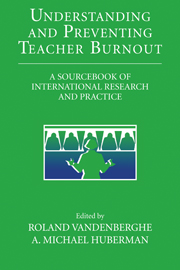Book contents
- Frontmatter
- Contents
- Contributors
- List of Figures
- List of Tables
- Foreword
- Introduction: Burnout and the Teaching Profession
- PART ONE TEACHER BURNOUT: A CRITICAL REVIEW AND SYNTHESIS
- PART TWO TEACHER BURNOUT: PERSPECTIVES AND REMEDIES
- PART THREE TEACHER BURNOUT: A RESEARCH AND INTERVENTION AGENDA
- References
- Index
Introduction: Burnout and the Teaching Profession
Published online by Cambridge University Press: 06 January 2010
- Frontmatter
- Contents
- Contributors
- List of Figures
- List of Tables
- Foreword
- Introduction: Burnout and the Teaching Profession
- PART ONE TEACHER BURNOUT: A CRITICAL REVIEW AND SYNTHESIS
- PART TWO TEACHER BURNOUT: PERSPECTIVES AND REMEDIES
- PART THREE TEACHER BURNOUT: A RESEARCH AND INTERVENTION AGENDA
- References
- Index
Summary
“Burnout” was first investigated in the 1970s as a crisis of overextended and disillusioned human service workers. Early interpretations centered on the collapse of the professional mystique; people entering these sectors presumably had developed unrealistic expectations on the basis of their training and general cultural background. Gradually, the problem was attributed more specifically to conflicts between caregivers' values for enhancing the lives of their recipients and limitations in the structure and process of human service organizations.
Unlike the classic, largely one-dimensional models of stress, the experience of burnout has been conceptualized in terms of three interrelated components: emotional exhaustion, depersonalization, and reduced personal accomplishment. In terms of outcomes, burnout has been linked to decrements in both psychological and physical well-being and has been associated with various problem behaviors, both on the job and in the home.
The nature of the syndrome has changed as human service professions have evolved. For example, the current experience of burnout occurs within a decidedly different social context, with human service workers struggling for social credibility and fearing job insecurity. Changes in mandates, retrenchments, and more skeptical perceptions of the worth of human service professionals have all realigned responsibilities and professional demands; they have altered the meaning of work and its underlying exchange agreement between professionals and their organizations.
- Type
- Chapter
- Information
- Understanding and Preventing Teacher BurnoutA Sourcebook of International Research and Practice, pp. 1 - 12Publisher: Cambridge University PressPrint publication year: 1999
- 14
- Cited by

